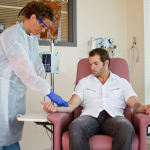In day-to-day conversation, likely you have heard someone use the term OCD out of context to describe wanting things to be a certain way, for example: “I am so OCD about organizing my closet,” or “They are so OCD when it comes to planning, why can’t they just relax?”. Or maybe you have heard things like, “I’m obsessed with that movie; it’s my favorite!”
Despite its frequent use and even misuse, obsessive-compulsive disorder is a mental health disorder that affects people of all ages, gender, ethnicity, sociodemographic, etc. It is significantly more intricate than wanting things a particular way, needing structure, or liking something a lot. Contrary to some misconception, those with OCD typically prefer NOT to perform the compulsion and often recognize that the obsession is irrational. Those afflicted experience intrusive thoughts that either result in the need to complete an action or repeat it in their mind repeatedly, thus causing a great deal of discomfort.
Obsessions are typically thoughts, images, scenarios, or impulses that pop up and sort of repeat play. Many reports that these thoughts are entirely out of their control and are often disturbing. These ideas are typically rooted in fear, shame, discomfort, disgust, and doubt and often leave the person unable to move on with their day. Most people experiencing this can recognize that these thoughts are irrational. Common obsessions include:
- Contamination: Germs, sexually transmitted disease, body fluids, COVID, Radiation, or chemicals
- Loss of control: of the self-resulting in: acting impulsively or outside of social norms, harming others, harming themselves
- Unwanted sexual thoughts: including perverse or forbidden images or impulses, children, or aggression
- Religious obsessions: fear of upsetting God, or Morality and what is right and wrong
- Harm: being responsible for a tragedy such as fire or burglary or harming someone because they aren’t careful enough (i.e., burning the house down because they forgot the oven was on)
- Perfectionism: Need to get things exact or perfect, fear of losing memory, fear of losing items
Compulsions are repetitive, almost ritualistic behaviors completed to appease the obsessive thought and either neutralize it, lessen its intensity, or temporarily make it go away. Despite recognizing that these tasks or actions don’t make sense, individuals with OCD will continue because they lack alternative coping methods and may even avoid any situation triggering an obsession (i.e., avoid the subway for fear of germs). Common compulsions include:
- Washing and cleaning- obsessively washing hands, showering, brushing teeth, or cleaning a space or object excessively
- “Checking”-making sure doors are locked, body parts or things are still intact, that a mistake hasn’t occurred or that nothing has been missed over and over despite not finding anything
- Repetition-re reading or rewriting, completing an activity over and over, repetitive body movements
- Counting- completing activities in multiples until it is at the “safe” or “good number.”
- Praying- to prevent harm or a bad thing from happening
- “Canceling out”- replacing a “bad word” with a good word so as not to “Jinx themselves”
Statistics, Causes and Risk Factors of OCD
According to the International OCD Foundation, somewhere between 2 and 3 million individuals in the United States are currently affected by obsessive-compulsive disorder. Despite this, significant causes remain unknown. Research suggests that OCD can run in families and genetics play a role, and stress can also exacerbate symptoms. Risk factors that increase the likelihood of OCD include depression, past trauma, anxiety or tics, or physical differences in the brain. Obsessive-compulsive disorder can manifest itself in a few other related conditions as well, including but not limited to the following:
- Pediatric Autoimmune Neuropsychiatric Disorders Associated with Streptococcal infections (PANDAS) occurs in some children due to a malfunctioning immune response to a strep infection. As a result, those afflicted can have radical changes in behavior overnight, showing aggression, moodiness, and repetitive body movements they can’t control.
- Body Dysmorphic disorder- This is a result of a concern or obsession with body image. As a result of this disorder, the person becomes hyper-focused on parts of the body, sees themselves as ugly, and can go through radical means to try and mitigate their “defect.” Behaviors also include repetitive behaviors like looking in the mirror and picking at the skin; the result of this obsession is that they have trouble functioning and focusing on other things.
- Trichotillomania-This is an impulse control disorder where the person pulls out their hair on the scalp, eyelashes, and eyebrows.
- Hypochondria or Somatic Symptom disorder- excessive unrealistic concerns about health and obsession with the fear of being very ill; Those afflicted will go to the doctor often due to this fear and will continue to worry even after medical testing.
- Hoarding- Those who suffer from hoarding find it painful to discard items and acquire many things to such a degree that the living environment can become unsafe.
Treatment of OCD
There is no “cure” for Obsessive-Compulsive Disorder; however, the use of psychotherapy utilizes several techniques that have shown evidence of decreased discomfort of symptoms. Cognitive Behavioral Therapy helps work through some of the thinking patterns associated with obsessions and compulsions. At times, exposure therapy is also incorporated into treatment to desensitize triggers and learn to manage compulsions at the moment. Mindfulness, meditation, and other relaxation techniques can also effectively reduce the discomfort around OCD symptoms. Medication is also often used in tandem with these techniques to help control obsessions and compulsions.
In situations where a person is medication-resistant or needs more support, additional options include Ketamine infusions. For those concerned about the side effects of medication or are medication resistant, Ketamine is a great option to lift anxiety, is fast-acting, and can even incorporate Psychotherapy during treatment. For more on this, check out Senior Associate Caroline Brown’s two-part series on Ketamine Assisted Psychotherapy.



